Rosé Wines

The process for making a rosé wine is similar to making a dry, unoaked white wine. The difference is that rosé is made with red grapes, so the key is to consider red grapes in their entirety: The skins are red, but the inside of most red grapes is translucent gray.
It is the skin of the red grape that gives color to juice and wine. If the clear juice from the red grapes is fermented without the skins, a white wine results. Ferment the skins and juice together for a short time, and the color is leached from the skins to the juice making the resulting wine pink. Ferment the skins and juice for a long time,
and the wine produced is red.
Rosé can be made from any red grape, and white Zin is made from— you guessed it—Zinfandel grapes, which are red. As far as flavor goes, white Zinfandel is generally sweeter and lighter in color than many rosé varieties. Rosé can be dry or sweet. It can also range in color from blush to bright red.